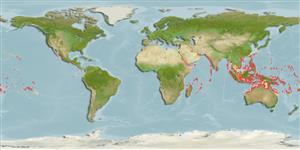>
Tetraodontiformes (Puffers and filefishes) >
Tetraodontidae (Puffers) > Canthigasterinae
Etymology: Canthigaster: Greek, kanthos = the outer or inner corner of the eye, where the lids meet, 1646 + Greek, gaster = stomach (Ref. 45335).
More on author: Richardson.
Issue
Occurrence of this species need to be reviewed.
Environment: milieu / climate zone / depth range / distribution range
Ecologia
marinhas associadas(os) a recifes; intervalo de profundidade 10 - 36 m (Ref. 1602). Tropical; 30°N - 24°S
Central Pacific, including Hawaiian Islands. Indian Ocean species were re-identified as Canthigaster petersii (Ref. 123151).
Population from the Philippines, Indonesia, New Guinea, Queensland, and Belau differs in coloration (formerly Canthigaster papua);
Replaced by Canthigaster margaritata in the Red Sea.
Tamanho / Peso / Idade
Maturity: Lm ? range ? - ? cm
Max length : 12.1 cm TL macho/indeterminado; (Ref. 126022); peso máx. publicado: 32.16 g (Ref. 126022)
Descrição suscinta
Chaves de identificação | Morfologia | Morfometria
Espinhos dorsais (total) : 0; Raios dorsais (total) : 8 - 10; Espinhos anais: 0; Raios anais : 8 - 10. Ocellus at base of dorsal fin; dark lines radiating from eye; caudal fin brown with pale spots, outer rows may form wavy lines (Ref. 4919).
Inhabit sheltered rocky reefs (Ref. 48637). Also live in intertidal reef flats, lagoon and seaward reefs. Occur over open barren areas, also among corals and under ledges (Ref. 9710). Benthopelagic (Ref. 58302). Often found in pairs, sometimes in small groups. Feed mainly on filamentous red and green algae and coralline red algae but also on corals, tunicates, mollusks, echinoderms, polychaetes, crustaceans and bryozoans. Common (Ref. 9710). Monogamous (Ref. 52884).
Ciclo de vida ou comportamento de acasalamento
Maturities | Reprodução | Spawnings | Egg(s) | Fecundities | Larvas
Oviparous (Ref. 205). Displays facultative monogamy where males are constrained to mate with a single female due to resource limitation (Ref. 52884).
Matsuura, K., S.V. Bogorodsky, A.O. Mal and T.J. Alpermann, 2020. Canthigaster aziz, a new deep-dwelling toby fish (Tetraodontiformes: Tetraodontidae) from the Red Sea. Zootaxa 4834(1):81-95. (Ref. 123151)
Status na Lista Vermelha da UICN (Ref. 130435)
Ameaça para os humanos
Harmless
Uso pelos humanos
Pescarias: espécies comerciais; Aquário: Espécies comerciais
Ferramentas
Relatórios especiais
Baixar XML
Fontes da internet
Estimates based on models
Preferred temperature (Ref.
123201): 26.1 - 29, mean 28 °C (based on 454 cells).
Índice de diversidade filogenética (Ref.
82804): PD
50 = 0.5000 [Uniqueness, from 0.5 = low to 2.0 = high].
Bayesian length-weight: a=0.03090 (0.01814 - 0.05264), b=2.84 (2.69 - 2.99), in cm total length, based on LWR estimates for this species & Genus-body shape (Ref.
93245).
Nível Trófico (Ref.
69278): 3.6 ±0.23 se; based on food items.
Resiliência (Ref.
120179): Elevada, tempo mínimo de duplicação da população menor que 15 meses (Preliminary K or Fecundity.).
Fishing Vulnerability (Ref.
59153): Low vulnerability (10 of 100).
Nutrients (Ref.
124155): Calcium = 110 [51, 262] mg/100g; Iron = 1.02 [0.49, 2.36] mg/100g; Protein = 18.1 [15.8, 20.2] %; Omega3 = 0.127 [0.061, 0.255] g/100g; Selenium = 35.6 [16.8, 79.4] μg/100g; VitaminA = 50.2 [13.8, 194.7] μg/100g; Zinc = 1.75 [1.11, 2.63] mg/100g (wet weight);
